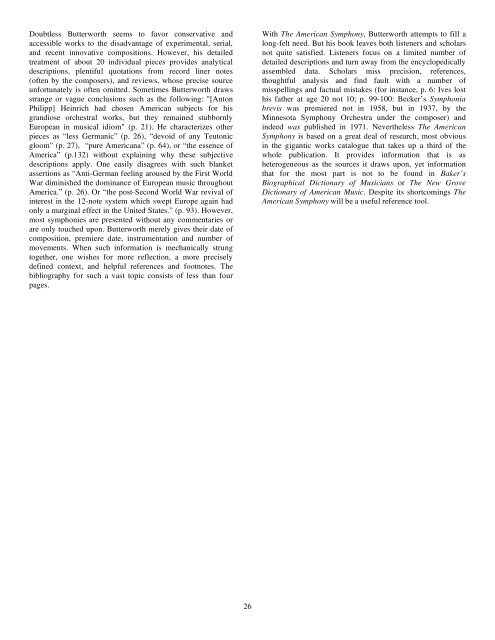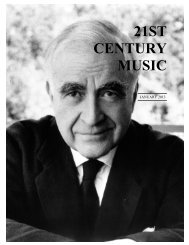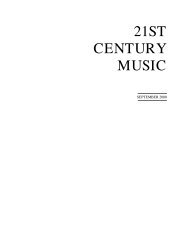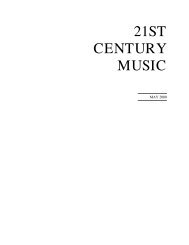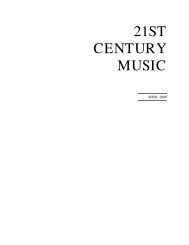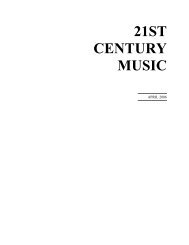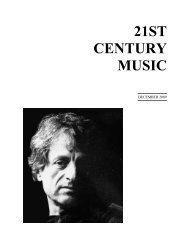Doubtless Butterworth seems to favor conservative andaccessible works to the disadvantage of experimental, serial,and recent innovative compositions. However, his detailedtreatment of about 20 individual pieces provides analyticaldescriptions, plentiful quotations from record liner notes(often by the composers), and reviews, whose precise sourceunfortunately is often omitted. Sometimes Butterworth drawsstrange or vague conclusions such as the following: "[AntonPhilipp] Heinrich had chosen American subjects for hisgrandiose orchestral works, but they remained stubbornlyEuropean in musical idiom" (p. 21). He characterizes otherpieces as “less Germanic” (p. 26), “devoid of any Teutonicgloom” (p. 27), “pure Americana” (p. 64), or “the essence ofAmerica” (p.132) without explaining why these subjectivedescriptions apply. One easily disagrees with such blanketassertions as “Anti-German feeling aroused by the First WorldWar diminished the dominance of European music throughoutAmerica.” (p. 26). Or “the post-Second World War revival ofinterest in the 12-note system which swept Europe again hadonly a marginal effect in the United States.” (p. 93). However,most symphonies are presented without any commentaries orare only touched upon. Butterworth merely gives their date ofcomposition, premiere date, instrumentation and number ofmovements. When such information is mechanically strungtogether, one wishes for more reflection, a more preciselydefined context, and helpful references and footnotes. Thebibliography for such a vast topic consists of less than fourpages.With The American Symphony, Butterworth attempts to fill along-felt need. But his book leaves both listeners and scholarsnot quite satisfied. Listeners focus on a limited number ofdetailed descriptions and turn away from the encyclopedicallyassembled data. Scholars miss precision, references,thoughtful analysis and find fault with a number ofmisspellings and factual mistakes (for instance, p. 6: Ives losthis father at age 20 not 10; p. 99-100: Becker’s Symphoniabrevis was premiered not in 1958, but in 1937, by theMinnesota Symphony Orchestra under the composer) andindeed was published in 1971. Nevertheless The AmericanSymphony is based on a great deal of research, most obviousin the gigantic works catalogue that takes up a third of thewhole publication. It provides information that is asheterogeneous as the sources it draws upon, yet informationthat for the most part is not to be found in Baker’sBiographical Dictionary of <strong>Music</strong>ians or The New GroveDictionary of American <strong>Music</strong>. Despite its shortcomings TheAmerican Symphony will be a useful reference tool.26
Calendar<strong>October</strong> 1Thomas Schultz performs Schoenberg's Six Little Piano Pieces,Galina Ustvolskaya's Sonata No. 6, and "Etude VIII" and "XXIII"from John Cage's Etudes Australes (1970). Dinkelspiel Auditorium,Stanford University, CA.Chen Yi's Duo Ye. Weill Recital Hall, New York, NY.<strong>October</strong> 7Premiere of Jake Heggie's Dead Man Walking. War Memorial OperaHouse, San Francisco, CA. Through <strong>October</strong> 28.A Concert in Honor of David Diamond's 85th Birthday. Piano Trio,Perpetual Motion, Canticle, Violin Sonata No. 1, and Cello SonataNo. 2. Merkin Concert Hall, San Francisco, CA.<strong>October</strong> 2San Francisco Contemporary <strong>Music</strong> Players in Carter's Tempo eTempi, San Martin's Rhondabout, Martino's Serenata Concertante,and Kim's Now and Then. Yerba Buena Center, San Francisco, CA.Falla's Suite Popular Español and Berio's Sequenza XI. Jordan Hall,New England Conservatory, Boston, MA.<strong>October</strong> 3Eighth Blackbird performs Lang's cheating, lying, stealing, Crumb'sVox Balaenae, Rzewski's Coming Together, Tower's Petroushskates,and Kellogg's Mysterium. Columbia University, New York, NY.Composers Concordance presents Ligeti's Etudes, Lee's Trio No. 4,Hardish's Sonorities II, Kramer's A Game, Pehrson's Stringing,Chambers's Endangered Species 2, Lehrman's Sonata for Violin andPiano, and Hyla's We Speak Etruscan. Frederick Loewe Theatre,New York University, New York, NY.64th birthday of Steve Reich. New York, NY.<strong>October</strong> 4Michael Tilson Thomas conducts the San Francisco Symphony inMahler's Symphony No. 7. Davies Hall, San Francisco, CA.Premiere of Glass's Symphony No. 5. BAM, New York, NY.<strong>October</strong> 5Z Program 8 (Infinity), with Pamela Z, Miya Masaoka, and The QubeChix. Z's Endless Loop and Gaijin, The Qube Chix's Bald Boyfriendand Information. Theater Artaud, San Francisco, CA.Lynn Torgove and Kayo Iwama in Prokofiev's Five Songs on Poemsby Anna Akhmatova and Hindemith's Nine English Songs. JordanHall, New England Conservatory, Boston, MA.Tcherepnin's Partita for Accordion, Bernstein's Sonata for Clarinetand Piano, Hindemith's Sonata for Flute and Piano, Stravinsky'sThree Pieces for Clarinet Solo, and Poulenc's Sonata for Clarinet andPiano. Keller Room, New England Conservatory, Boston, MA.Battey's Uroborous -- Light and Sound. Jack Straw, Seattle, WA.<strong>October</strong> 6Chen Yi's Fiddle Suite performed by the Singapore Symphony.Singapore. Through November 11, Lucerne, Switzerland.<strong>October</strong> 8Patti Deuter in Debussy's Pour Le Piano and La Plus Que Lente, andPoulenc's Nocturnes. Melissa Smith in Poulenc's Trois Novelettes.Eliane Lust Studio, San Francisco, CA.<strong>October</strong> 10La Rocca's Credo, Moe's O Vos Omnes, Winges's Wishes Night, andexcerpts from Rands's Canti d'amor and Thomson's Four Saints inThree Acts. Green Room, Veterans Building, San Francisco, CA.<strong>October</strong> 1120/21 Club: Renée Fleming. Columbia University, New York, NY.Sara Laimon and Frederic Rzewski. Jazz Gallery, New York, NY.<strong>October</strong> 12SF Symphony in Kodály's Hary Janos Suite and Lutoslawski'sConcerto for Orchestra. Davies Hall, San Francisco, CA.Chen Yi's Eleanor's Gift. Roosevelt University, Chicago, IL.Ensemble 21 presents pianist Marilyn Nonken in Ives's Sonata No. 2("Concord, Mass. 1840-1860"), and Finnissy's North AmericanSpirituals and Kemp's Morris. Columbia University, New York, NY.Anthony de Mare and Frederick Rzewski. Jazz Gallery, NY, NY.<strong>October</strong> 13West Coast premiere of Glass's Symphony No. 5 in 12 Parts. OrangeCounty Performing Arts Center, CA.Weill at Heart, directed by Harriet March Page, with Mark Alburger,Diana Landau, Douglas Mandell, Miriam Lewis, and Sharon Walters.Goat Hall, San Francisco, CA. Through <strong>October</strong> 23.Experimental Frontiers: Cage, Feldman, Cardew, Young, Brown.Williams Hall, New England Conservatory, Boston, MA.Katherine Supové and Anthony de Mare. Jazz Gallery, NY, NY.<strong>October</strong> 14C'est Poulenc!, with Patti Deuter, Melissa Smith, David Saslav, AnneOliver, Elizabeth Lee, Michael Kimbell, Edmund Kimbell, andKathleen Johannessen. Sanchez Concert Hall, Pacifica, CA.


